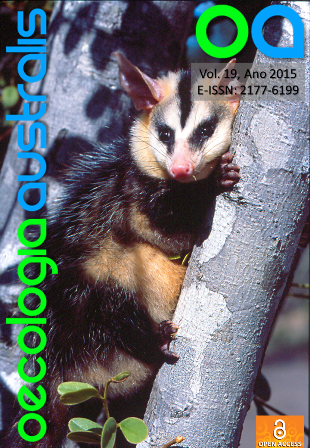POPULATION DYNAMICS OF CERRADOMYS GOYTACA, A COASTAL SANDY PLAIN ENDEMIC RODENT
DOI:
https://doi.org/10.4257/oeco.2015.1901.13Palavras-chave:
Seasonality, Climatic factors, Population ecology, AdaptationResumo
Restingas are coastal sandy plains that harbor peculiar ecosystems due to their soil and microclimatic conditions, showing dominance of arid and semi-arid adapted plant species even though located in humid tropical and subtropical climates. The population dynamics of rodents have been studied in very few restingas, making it difficult for predictions on the relative roles of climatic factors in demographic parameters of these mammals. In this paper we describe the population dynamics of the restinga endemic rodent, Cerradomys goytaca, based on a capture-mark-recapture three-year study (2011-2014) conducted in the Restinga de Jurubatiba National Park, located in the northern littoral of Rio de Janeiro state. The relations among climatic factors and population parameters were also investigated by multiple linear regression models to evaluate putative differences in the demographic strategy of this species compared to other Atlantic forest rodents. Cerradomys goytaca exhibited seasonal fluctuations in population size, with maximum sizes peaking at colder months during the dry season. The models best supported by the data evidenced monthly temperature and not precipitation as the most influential climatic variable in population size, reproductive rate and survivorship. The annual survivorship was relatively higher than those estimated in Atlantic forest species and the population size oscillations were slighter than in those observed in other restinga rodents. Allied to the lower dependence to rainfall, these characteristics suggest a distinct demographic strategy possibly related to the life in more xeric formations.
Downloads
Arquivos adicionais
- Cover Letter
- camiladebarros, 960-6236-2-ED Reviewer B mod Nat.docx
- camiladebarros, 960-6236-3-ED Reviewer E mod Nat.docx
- camiladebarros, 960-6236-5-ED mod Nat.docx
- camiladebarros, 960-6236-10-ED mod nat.doc
- camiladebarros, 960-6236-7-ED.tif
- camiladebarros, 960-6236-8-ED.tif
- camiladebarros, 960-6236-9-ED.tif
Publicado
2017-02-23
Edição
Seção
Artigos


